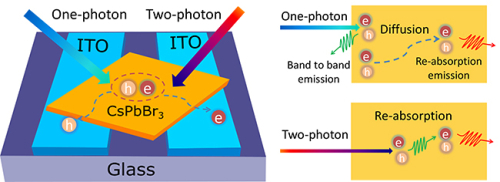Dalian Institute of Materials Chemistry progresses in research on the dynamics of the whole inorganic perovskite photodetector
ã€Chinese instrument network instrument research and development】 Recently, Han Keli, a researcher of the Complex Molecular System Reaction Dynamics Group of the Dalian Institute of Chemical Physics, Chinese Academy of Sciences, has made new progress in the study of the dynamics of all-inorganic perovskite photodetectors. The research team found that there was a rapid diffusion behavior of the carriers in the whole inorganic perovskite crystallite (CsPbBr3) excited state, and the photodetectors thus prepared had ultra-high sensitivity and fast time response. The relevant research results were published in Advanced Materials.

Photodetectors play an important role in signal processing, communications, and bioimaging. At present, all-inorganic perovskite-based photodetectors cannot achieve high sensitivity and fast response at the same time. For example, CsPbBr3 perovskite films have higher trap state density, and the charge collection efficiency of CsPbBr3 perovskite single crystal photodetectors is very low. . Photodetectors based on these materials generally have low sensitivity and long response times.
Low defect state density, high carrier mobility, and effective charge collection are important factors in achieving high performance photodetectors. The research team prepared organic-inorganic hybrid perovskite crystallites in 2016. On this basis, the CsPbBr3 crystallites with lower defect density were quickly synthesized by the solution method. The time-resolved luminescence spectra were studied. It was found that the fluorescence decay kinetics of single-photon excitation depended on the emission wavelength, and the fluorescence attenuation kinetics of two-photon excitation was independent of the emission wavelength. The analysis shows that there are rapid diffusion behaviors of carriers in the excited state of CsPbBr3 crystallites, and the carrier mobility exceeds 100cm2V-1S-1. High-efficiency charge collection can be achieved by constructing a CsPbBr3 micron photodetector with ultra-high response (104A/W), which refreshes the highest reported value of all-inorganic perovskite photodetectors. Simultaneously achieve single-photon and dual-light response. In addition, the photodetector has a fast response time (1ms). This work provides new ideas for the preparation of high-performance photodetectors.
The above work was funded by key projects of the National Natural Science Foundation of China.
(Original title: Advances in Kinetics of Photodetectors for Inorganic Perovskite Photodetectors at Dalian Institute of Materials)
Glass Autoclave,Autoclave Lamination,Glass Lamination Autoclave,Glass Laminating Autoclave
Changzhou machinery and equipment Imp.& Exp.Co.,Ltd , https://www.czautoclave.com